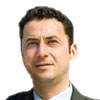Response to first anti-epileptic drug predicts future seizures?
How well people with newly diagnosed epilepsy respond to their first drug treatment, may signal the likelihood that they will continue to have uncontrolled seizures according to University of Melbourne Chair of Neurology Professor Patrick Kwan.
In a study published in Neurology, the medical journal of the American Academy of Neurology, Professor Kwan, who is also head of the clinical epilepsy program at the Royal Melbourne Hospital and an international authority in antiepileptic drug development, believes a pattern emerges in the early stages.
“Our research shows a pattern based on how a person responds to initial treatment and specifically, to their first two courses of drug treatment,” said Dr Kwan.
For the study, 1,098 people from Scotland between the ages of nine and 93 with newly diagnosed epilepsy were followed for as long as 26 years after being given their first drug therapy. Participants were considered seizure-free if they had no seizures for at least a year without changes in their treatment. If they had further seizures, a second drug was chosen to be given alone or to be added to the first. If seizures continued, a third drug regimen was selected, and the process continued for up to nine drug regimens.
The study found that 50 percent of the people were seizure-free after the first drug tried, 13 percent were seizure-free after the second drug regiment tried and 4 percent were seizure-free after the third. Less than two percent of the participants stopped having seizures on additional drug treatment courses up to the seventh one tried, and none became seizure-free after that.
The research also found that 37 percent of people in the study became seizure-free within six months of treatment. Another 22 percent became seizure-free after more than six months of starting treatment. Both groups continued to be seizure-free. However, 16 percent had fluctuating periods of seizure freedom and relapses, and 25 percent were never seizure-free for one year.
At the end of the study, 749 people (68 percent) were seizure-free and 678 people (62 percent) were on only one drug. The results were independent of the age when the person had the first seizure or the type of epilepsy.
“A person who doesn’t respond well to two courses of epilepsy drug treatment should be further evaluated to verify an epilepsy diagnosis and to identify whether surgery or other treatment modalities is the best next step,” said Professor Kwan. “While freedom from seizures is the goal of treatment, we still have to consider quality of life issues for each individual patient.”
Affecting 50 million people worldwide, epilepsy is the most common serious neurological disorder and a major global public health issue. Identifying drug resistance promptly and understanding the genetic risk factors predisposing to epilepsy and drug resistance can help doctors find better treatment and potentially preventive therapy.
(Source: University of Melbourne: Neurology)
More Information
 | For more information on epilepsy and its treatments, and some useful animations and videos, see Epilepsy. |
Dates
Tags
Created by:

 Login
Login














